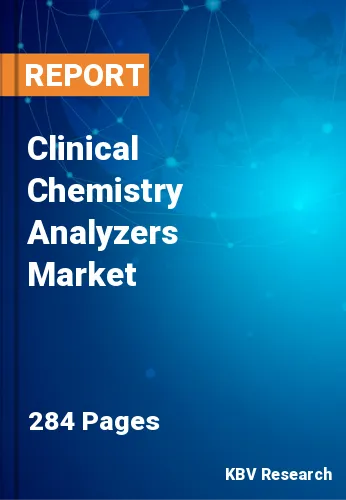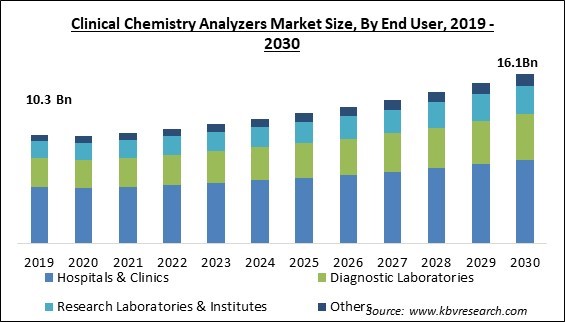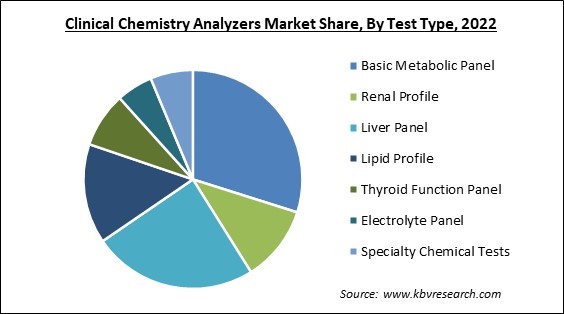
The Global Clinical Chemistry Analyzers Market size is expected to reach $16.1 billion by 2030, rising at a market growth of 5.2% CAGR during the forecast period.
Numerous illnesses and problems may develop as people age. Most diseases that affect people in their senior years have a strong immune component. The Diagnostic Laboratories segment will register around 30% share in the market by 2030, as a result, there is a higher demand for diagnostic and treatment tools, such as laboratory tests. The elderly population is increasing alarmingly quickly in every nation on the earth. Nearly 1.5 billion people will inhabit the planet by 2050, an increase of more than three times the current number. Additionally, during this time, it is predicted that the percentage of elderly citizens will increase to 16.0% worldwide. In the middle of the twenty-first century, one in six people will be 65 or older. The "population aging phenomenon" describes the rise in the proportion and prevalence of older persons globally. Additionally, 703 million people worldwide were 65 or older in 2019. Some of the factors impacting the market are rapid evolution of clinical chemistry analyzers owing to R&D, increasing rates of chronic or noncommunicable diseases, and the need for large capital investments.

Government programs, initiatives, and financial aid intended to foster the expansion of laboratories and diagnostics are expected to have a positive impact on the market. The market has continually grown, largely as a result of technological development. Ongoing R&D projects and the adoption of cutting-edge software developments in clinical laboratories are expected to affect the future of the market. In hospitals, point-of-care diagnostic centers, and research labs, the technological improvements in clinical chemistry analyzers will result in increased efficiency of workflow. Additionally, there is a rising need for cutting-edge and effective testing and diagnosing methods as chronic diseases like cancer, heart disease, and diabetes become increasingly common. Noncommunicable diseases (NCDs) account for 41 million annual deaths, or 74% of all fatalities worldwide, according to the World Health Organization (WHO). An NCD causes 17 million deaths worldwide each year before age 70; 86% of these premature deaths occur in low- and middle-income nations. Therefore, the market will grow due to technological advances and the rising burden of chronic diseases.
Furthermore, Due to the COVID-19 pandemic, the healthcare system faced significant difficulties. Since most chronic therapy was considered non-urgent, all outpatient treatments were delayed or canceled during the pandemic to lower the danger of viral transmission. During the pandemic, clinical chemistry assays and serological testing assisted in tracking the general health of infected people. Among the clinical chemistry tests described were total bilirubin, albumin, alanine aminotransferase (ALT), lactate dehydrogenase (LD), and aspartate aminotransferase (AST). The COVID-19 pandemic increased these tests' use, significantly contributing to the market's expansion. Thus, the market is anticipated to reach pre-pandemic levels throughout the projection period.
However, several constraints limit the market expansion. First, major hospitals and reference labs with sizable capital budgets are the only places where high-volume clinical chemistry analyzers are affordable. Small laboratories, doctor's offices, and solo practitioners frequently lack the financial capacity to purchase large or extremely large-sized analyzers, which limits their ability to adopt cutting-edge equipment. These analyzers cannot be used effectively due to insufficient specialists. Therefore, the market growth is constrained by the restricted availability of high-volume analyzers at affordable prices for smaller healthcare institutions as well as the global workforce shortage.
By end user, the market is categorized into hospitals & clinics, diagnostic laboratories, research laboratories & institutes, and others. The hospitals and clinics segment procured the maximum revenue share in the market in 2022. The segment's growth can be linked to a number of variables, including the global increase of hospitals due to the increased occurrences of disorders and diseases. In addition, the market has experienced substantial expansion due to the increasing deployment of analyzers in various clinic and hospital settings as well as technological improvements.

On the basis of test type, the market is segmented into basic metabolic panel, liver panel, renal profile, lipid profile, thyroid function panel, electrolyte panel, and specialty chemical tests. The liver panel segment recorded a significant revenue share in the market in 2022. A liver panel is used to monitor and assist in the diagnosis of liver disorders. With the rise in liver disorders, the demand for these tests will increase, propelling the expansion of the segment.
Based on product, the market is divided into reagents, analyzers, and others. The reagents segment garnered the highest revenue share in the market in 2022. The growth of the segment is owed to the ongoing need for reagents as these are essential to clinical chemistry analyzers because they are critical in supporting reliable and accurate laboratory testing. Enzymes, substrates, certain proteins, lipids, electrolytes, and other reagents are among those that are most commonly used in analytical techniques and are essential for obtaining reliable findings.
| Report Attribute | Details |
|---|---|
| Market size value in 2022 | USD 10.8 Billion |
| Market size forecast in 2030 | USD 16.1 Billion |
| Base Year | 2022 |
| Historical Period | 2019 to 2021 |
| Forecast Period | 2023 to 2030 |
| Revenue Growth Rate | CAGR of 5.2% from 2023 to 2030 |
| Number of Pages | 283 |
| Number of Table | 400 |
| Report coverage | Market Trends, Revenue Estimation and Forecast, Segmentation Analysis, Regional and Country Breakdown, Companies Strategic Developments, Company Profiling |
| Segments covered | Test Type, Product, End User, Region |
| Country scope | US, Canada, Mexico, Germany, UK, France, Russia, Spain, Italy, China, Japan, India, South Korea, Singapore, Malaysia, Brazil, Argentina, UAE, Saudi Arabia, South Africa, Nigeria |
| Growth Drivers |
|
| Restraints |
|
Region-wise, the market is analyzed across North America, Europe, Asia Pacific, and LAMEA. The North America region recorded the highest revenue share in the market in 2022. The market in North America grew as a result of various factors, including an aging population, a rise in the prevalence of chronic diseases, and supportive government policies. Additionally, the rising healthcare costs, a well-developed healthcare system, and the accessibility of cutting-edge instruments have led to an increased number of testing being conducted in the region, creating demand for assays and analyzers.
The market research report covers the analysis of key stake holders of the market. Key companies profiled in the report include F. Hoffmann-La Roche Ltd., Danaher Corporation, Abbott Laboratories, Thermo Fisher Scientific, Inc., Siemens Healthineers AG (Siemens AG), Horiba Ltd., Sysmex Corporation, Hitachi, Ltd., EKF Diagnostics Holdings plc and Ortho-Clinical Diagnostics, Inc. (QuidelOrtho Corporation).
Free Valuable Insights: Global Clinical Chemistry Analyzers Market size to reach USD 16.1 Billion by 2030
By End User
By Test Type
By Product
By Geography
The Market size is projected to reach USD 16.1 billion by 2030.
Increasing rates of chronic or noncommunicable diseases are driving the Market in coming years, however, Need for large capital investments restraints the growth of the Market.
F. Hoffmann-La Roche Ltd., Danaher Corporation, Abbott Laboratories, Thermo Fisher Scientific, Inc., Siemens Healthineers AG (Siemens AG), Horiba Ltd., Sysmex Corporation, Hitachi, Ltd., EKF Diagnostics Holdings plc and Ortho-Clinical Diagnostics, Inc. (QuidelOrtho Corporation).
The expected CAGR of this Market is 5.2% from 2023 to 2030.
The Basic Metabolic Panel segment is leading the Market by Test Type in 2022; thereby, achieving a market value of $4.3 billion by 2030.
The North America region dominated the Market by Region in 2022 and would continue to be a dominant market till 2030; thereby, achieving a market value of $5.5 billion by 2030.
Our team of dedicated experts can provide you with attractive expansion opportunities for your business.
